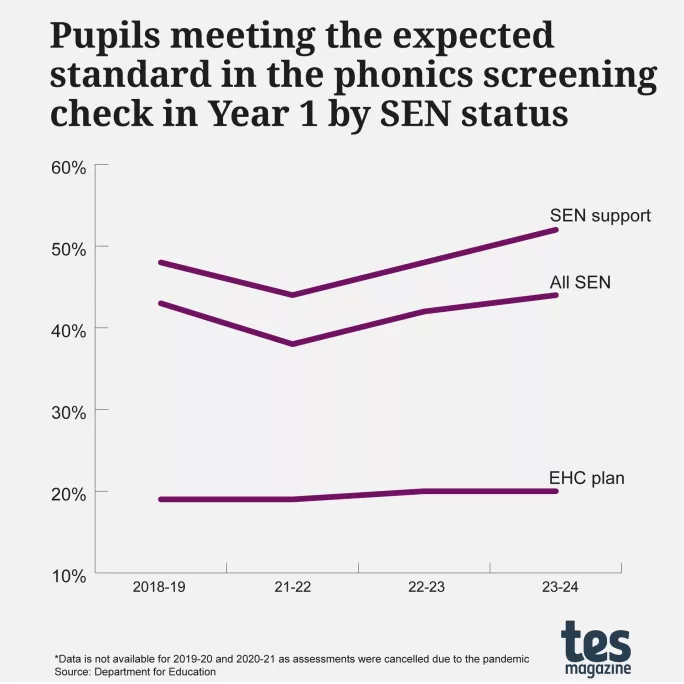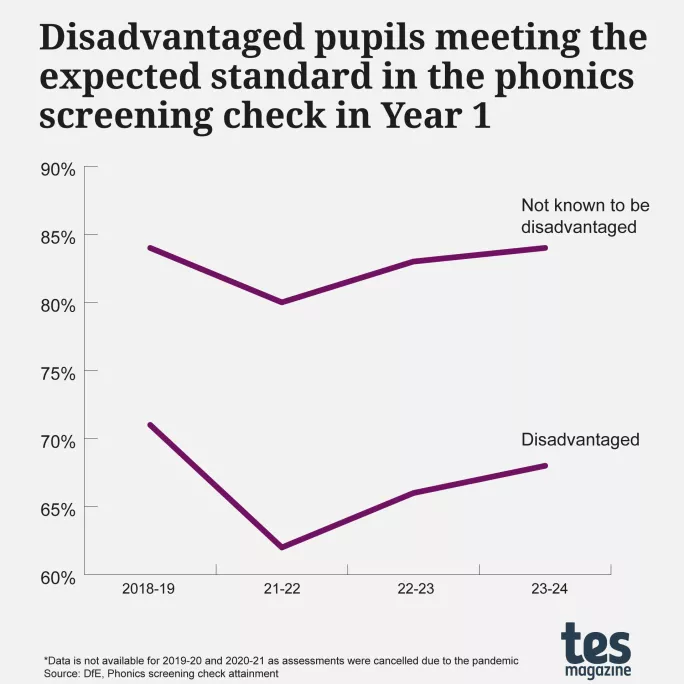Phonics check results: 7 insights for teachers and leaders

Phonics screening check data was published yesterday, breaking down outcomes for pupils by a host of different criteria.
We’ve been through this data to draw together the key insights that primary teachers and leaders need to know from the Year 1 results - from the potential impact of the policy to why the pandemic is still casting a shadow over learning outcomes.
Phonics screening check data: main insights
1. Overall results
As the table below shows, there has been another small rise in overall attainment, although the level remains below what it was before the pandemic. This suggests that the impact of the pandemic on the early years remains an issue.

Mark Chatley, trust leader at Coppice Primary Partnership in Kent, says the loss of speech and language opportunities during the pandemic restrictions means that many pupils have been behind in this area.
“If we assume that in order to read and spell a word, we also need to be able to say the word, speech and language is key. If we can’t hear sounds in a word, it would be difficult - near impossible - for us to decode the word,” the says.
“During Covid, so many external services for babies stopped. This meant that for many, exposure to things such as baby and toddler groups, visits from health professional, NCT groups, etc, all were less accessible and remote.”
The impact of this should recede for next year’s cohort, though, so it will be interesting to see if there is a notable increase in the national average in 2025.
- Phonics screening check: All you need to know
- Last year: Phonics attainment up but still below pre-pandemic levels
- Pupil wellbeing: How to reduce the stress of the phonics screening check
Paul Whiteman, general secretary of the NAHT school leaders’ union, says that while it is positive that results are improving, he hopes the pandemic effect will soon be a thing of the past.
“The reality is this test tells teachers little that they won’t already know through the assessments they make of pupils’ progress every day,” he says.
“That’s why we believe the phonics screening check should be made optional on the back of the government’s new curriculum and assessment review, as part of a broader move to reduce the number of high-stakes tests that children take.”
2. Gender gaps
Looking at attainment by gender, we can see that - as ever - girls outperform boys. However, here, too, there is a gap between this year’s scores and pre-pandemic scores - and the gap is around the same for each sex.
Again, the fact that these figures are below the pre-pandemic years shows that it will be worth watching to see if they rise next year.

3. SEND outcomes
Another clear difference can be seen in the outcomes of pupils with special education needs and disabilities (SEND), and especially those with an Education, Health and Care Plan (EHCP).
As you may expect, those with an EHCP did not perform as well as those with SEN support, and when these categories are combined as an average, there is a huge difference compared with non-SEND pupils’ outcomes. This shows how early within education that these inequalities start to appear.

Pepe Di’Iasio, general secretary of the Association of School and College Leaders (ASCL), says the results make it clear that more has to be done to support pupils with SEND from an early age within the education system.
“A huge part of getting the early years system right is investment in early intervention to support children with SEND,” he tells Tes.
“If all pupils have access to appropriate support at the point they need it, this will make a noticeable difference to attendance, attainment and their overall wellbeing.”
4. Attainment by month of birth
Being born in September still gives pupils the best chance of being top of the class when it comes to phonics (as it does for many other attainment tests).
The disparity in outcomes is quite stark, too, with 13 per cent fewer pupils born in August meeting the expected standard compared with those born in September.
March remains the pivotal point for achieving the national average - suggesting that schools may want to consider focusing on those born after this to help boost overall scores.

However, Chatley notes that some children taking the test have been alive for almost 20 per cent less time than their peers, meaning there is only so much that schools can do to try to level the playing field. “Interventions could help, but they can’t replace the time children haven’t yet had,” he says.
As such, he suggests that the bigger focus should always been on identifying children who are genuinely behind, regardless of their birth month.
“While having an eye on any specific demographics, including month of birth, is important, I wouldn’t advocate grouping by birth month as much as I would by what the evidence from my ongoing assessments was telling me,” Chatley says.
5. Outcomes by school type
Overall, there is a slight difference in outcomes based on school type. Although it is worth noting that while free schools achieved the best outcomes, this data was drawn from a source of just 300 schools, compared with several thousands for the other categories.

6. Regional differences
London leads the way in terms of overall outcomes, although there is only a couple of percentage points between all of the regions.
Perhaps what is more notable is just how uniform the recovery since the pandemic has been. This shows how each region’s outcomes are baked in and so efforts to “level up” any particularly region have fallen flat.

7. The disadvantage gap persists
Labour has made a big play of wanting to improve early years education, such as through free breakfast clubs and better links between early years settings and schools.
As such, the government may want to take note of the fact that, while scores for both disadvantaged pupils and pupils not known to be disadvantaged have risen since the pandemic, the gap between them has remained almost identical.
Clearly, then, even from a very young age, being disadvantaged leaves pupils behind their peers and this is an issue that will follow most of them through school.

As such, support for disadvantaged children from the start of education to give more of them a solid foundation will be crucial to boost outcomes.
Di’Iasio says the fact that these disadvantage gaps have “persisted for years” proves that a different approach is needed. He adds that Labour’s policies in this area to try to boost early years outcomes are welcome but they require financial backing.
Falling pupil rolls in primary schools provide the government with an opportunity to raise per-pupil funding levels and support schools to ensure that all pupils achieve the best possible outcomes, Di’Iasio says.

Keep reading for just £1 per month
You've reached your limit of free articles this month. Subscribe for £1 per month for three months and get:
- Unlimited access to all Tes magazine content
- Exclusive subscriber-only stories
- Award-winning email newsletters
topics in this article



